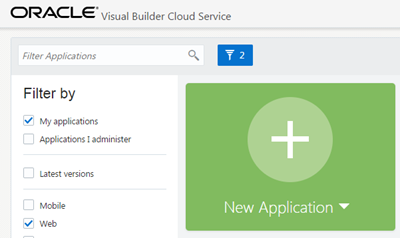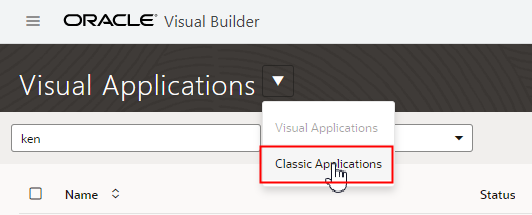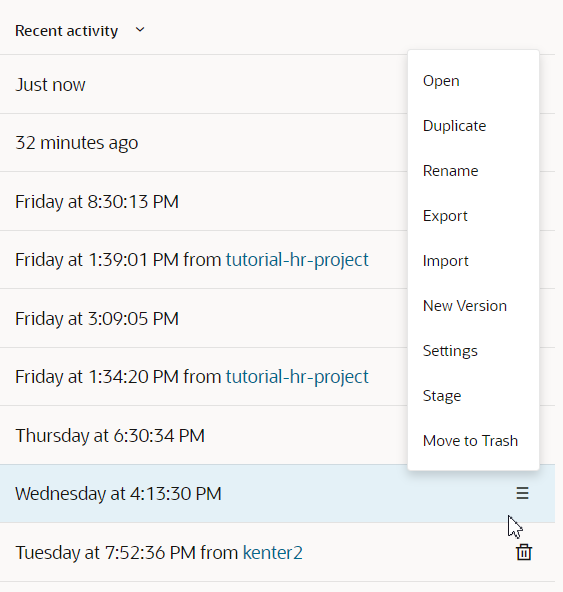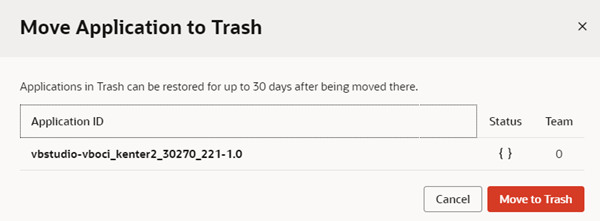Manage Applications in the Service Instance
The Oracle Visual Builder Home page helps you manage visual applications created on the current Visual Builder service instance, as well as apps deployed to the instance from a different VB instance or Visual Builder Studio (VB Studio).
Each row on the Home page represents an application created either on a Visual Builder instance, or on a VB Studio instance that is associated with this Visual Builder instance. The Origin column on the Home page contains "Visual Builder Studio" if the app was shared or published in Visual Builder Studio:
The first row in the image above represents an application created on this VB instance, which can be managed using the ![]() in the right column. The rows below represent applications created on a VB Studio instance, and the only option on the Home page for these is to click
in the right column. The rows below represent applications created on a VB Studio instance, and the only option on the Home page for these is to click ![]() in the right column to remove them from the VB instance. To manage an app created in VB Studio, you should open the app's VB Studio project. The VB Studio project provides tools for managing an application's lifecycle that are equivalent to those in the Options menu for applications created on the VB instance. For example, in the project's Builds tab you can configure a build job to set the app's version and then stage it. For more about managing an application's lifecycle in VB Studio, see Preview, Share, and Deploy Visual Applications in Building Responsive Applications with Visual Builder Studio.
in the right column to remove them from the VB instance. To manage an app created in VB Studio, you should open the app's VB Studio project. The VB Studio project provides tools for managing an application's lifecycle that are equivalent to those in the Options menu for applications created on the VB instance. For example, in the project's Builds tab you can configure a build job to set the app's version and then stage it. For more about managing an application's lifecycle in VB Studio, see Preview, Share, and Deploy Visual Applications in Building Responsive Applications with Visual Builder Studio.
If you’re an administrator, you can manage (which includes deleting) any of the apps shown on the Home page. To see the full list of applications, select the Administered by me checkbox next to the Status dropdown list.
If you’re a developer, you can manage the apps that you’ve created in this instance of Visual Builder, or if you're a team member of the app. You can also manage VB Studio apps from the Home page, as long as you’ve created, shared or published it. You will not see the Administered by me checkbox unless you have the role of administrator.
IDCS Client Applications
Each time a visual application is created on a Visual Builder instance, a companion client application is automatically created in IDCS. When you stage or publish the app to a different server governed by the same IDCS instance, another client application is created. This means there may be several client applications for the same visual application running on IDCS for the lifespan of the app.
If you have IDCS administrator privileges, you can see these client apps on the IDCS console, but you should not need to manage them in any way. When a visual application is removed from the server, the associated client apps are removed from IDCS. You may need to interact with the client apps if you want to set login-related policies for a Visual Builder service instance—for example, to enable the Keep me signed in policy, or to assign the users and groups who can access the application.
- When the URL contains
<SUB-DOMAIN>.builder.ocp.oraclecloud.com, the VB instance will have its own IDCS app. - When the URL contains
<SUB-DOMAIN>.integration.ocp.oraclecloud.com, it is an OIC instance, and the VB instance will share the OIC instance's IDCS app.
For more, see Typical Workflow for Managing Oracle Identity Cloud Service Applications in Administering Oracle Identity Cloud Service.
Tip:
Developers can also view details of client apps created in IDCS for their visual applications and can provide details of the exact client app to help you troubleshoot issues more easily. See How Do I View Details of Client Apps in IDCS? in Developing Applications with Oracle Visual Builder.Visual Builder Classic Applications
If you have any classic applications (apps that have the older Visual Builder project structure), open the Visual Applications dropdown list in the header and select Classic Applications.
On the Home page for classic applications, administrators can select the Applications I administer checkbox in the Filter by pane to display the applications where they are not a team member.

Description of the illustration admin-homepage1.png
Manage Applications Created on the Instance
The table of applications on the Home page includes visual applications created on the Visual Builder instance. Each of these applications has an Options menu in the right column that developers and administrators can use to manage it, for example, to add and remove team members, and to open, stage and publish the application.
You can tell which applications were created on the instance by looking for ![]() in the right column. If you see a
in the right column. If you see a ![]() button instead of
button instead of ![]() , the application was created on a different instance of Visual Builder or a VB Studio instance. If an application was created on a different instance, you'll need to open the application on the instance where it was created and manage it there.
, the application was created on a different instance of Visual Builder or a VB Studio instance. If an application was created on a different instance, you'll need to open the application on the instance where it was created and manage it there.
To manage an application created on the current Visual Builder instance:
-
Click
 in the right column of the application, and then select a task in the Options menu:
in the right column of the application, and then select a task in the Options menu:
The Options menu displays commands for managing the application (based on the application's status, some commands might be hidden):
| Menu Item | Description |
|---|---|
| Open |
Opens the development version of the application |
| Duplicate |
Creates a clone of this version of the application, including the content of the database. |
| Rename |
Opens a dialog box where you can change the name of the application. |
| Export |
Creates a ZIP archive of the application that can be imported as a new application. When exporting the application, you can choose if you want the exported archive to include the data stored in your business objects. |
| Import |
Opens a dialog that you can use to create an application by uploading an application archive (ZIP or OVB) from your local system. |
| New Version |
Creates a new version of the same application. By default the new version is a development version. Version numbers are automatically increased incrementally. |
| Settings |
Opens an editor for configuring the application’s settings and viewing the application API URLs. Each application version has a dedicated Settings editor. |
| Stage |
Opens a dialog box where you can specify the database option for the staged application. When an application is staged, a link to the staged version is displayed in the tile. |
| Publish |
Opens a dialog box where you can specify the database option and publish the staged version of your application. |
| Lock / Unlock |
Enables you to lock a live application to prevent any users from using the application. You would usually use this command when you are going to update the live application with a newer version. The Unlock option is displayed only when the live application is locked. |
| Rollback |
Rolls back the live version to the previous live version. This is only available for the current live version, and there must be an older live version of the app. |
| Move to trash |
Deletes the application from the Identity Domain. You have 30 days to recover the application after deleting it. For more, see Delete a Visual Application in Developing Applications with Oracle Visual Builder. |
Manage Applications Created on a VB Studio Instance
When a VB instance is associated with a VB Studio project, visual applications created, shared and published in the VB Studio project are included on the Home page. These applications are visible to administrators, and to the developers who created the applications.
When you create a visual application in VB Studio, you do so in the context of a workspace, a completely private area where your app and its assets are stored. While creating your workspace, you are asked to designate an instance of Visual Builder to serve as the target for deployment; you don’t deploy visual apps to a VB Studio instance. In addition to serving as a deployment target, the Visual Builder instance you name is also used to support the creation of business objects, as well as the VB Studio Share and Publish actions. That is, if you create a business object in the context of your app, a new app representing the schema for that object is created in the VB instance associated with your workspace. In the image below, the third row shows such a schema-based app; the first row represents an app that was published in VB Studio, and the second row represents the app after the Share action is used in VB Studio.
You can tell if an application was created on a different VB instance or a VB Studio instance because there will be a ![]() button in the right column, and the only option on the Home page is to remove the application. To perform other tasks, for example, to add members to the team, you need to open the application in the instance where it was created. For apps created in VB Studio, you can use the link in the Recent activity column to open the app's VB Studio project.
button in the right column, and the only option on the Home page is to remove the application. To perform other tasks, for example, to add members to the team, you need to open the application in the instance where it was created. For apps created in VB Studio, you can use the link in the Recent activity column to open the app's VB Studio project.
To remove an application from the current Visual Builder instance:
- Locate the row in the table containing the application.
- Do one of the following:
- Click the
 button in the right column.
button in the right column.
- Select one or more applications, then click Move to trash in the header.
- Click the
-
Confirm the applications you want to delete by clicking Move to Trash in the Move Application to Trash dialog box.
For details on deleting multiple versions of applications, and live or live locked versions, see Delete a Visual Application.
This table describes the types of applications that will appear on the Home page when developing a visual application in VB Studio.
| When you ... | Description |
|---|---|
| Create a workspace for an application |
A "container" application for the application's business objects is automatically created on the VB instance. This represents the schema for the business objects used in a visual app's workspace. On the Home page:
This image shows two apps, each representing a workspace in a Visual Builder Studio project: If the application for a workspace is removed on the Home page, it's automatically generated again the next time the workspace is opened. Note: No client application is created in IDCS for these container applications created for workspaces. |
| Share a visual application |
The application is staged on the VB instance, and a client application is created for the app's 'development' app profile and added to the list of applications in the IDCS environment. An application representing the client application is also added to the VB instance Home page table. Though sharing the application might create multiple client apps, the table will only list one application for the shared app. The application name on the Home page is usually the name of the visual application. On the Home page:
This image shows what two visual application shared from two VB Studio workspaces in a project might look like when viewed on the Home page: Note: If the client application is removed on the Home page or in IDCS, the shared application will not work correctly. If the shared application is no longer needed, you can remove the application. |
| Publish an application |
The application is deployed to the VB instance, and a client application for the app's 'stage' (or 'publish') app profile is created and added to the list of applications in the IDCS environment. An application representing the client app is also added to the VB instance Home page table. In the table, the application name will usually be the name of the visual application. This name can be changed in the application's On the Home page:
This image shows what an application published from Visual Builder Studio might look like when viewed on the Home page: Note: If the client application of a live or staged app is removed, on the Home page or in IDCS, the application will not work correctly. If the application is no longer needed, you can remove the application. |







